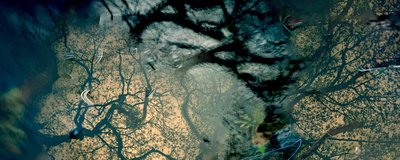Afterimages, Counterimages and Organic Abstraction

Abstract
Relational tools for speculative ecologies
Unearthing photographic remains as stacks or strata of a planet-centred perception, this deconstructed photobook and instant exhibition, created as a series of afterimages, gathers visual notes by Rasa Alksnyte, Nik Gaffney and Maja Kuzmanović, spanning varied geographies and decades of walking and watching. This leporello exhibition unites images of distant ecosystems in a dense and compact exhibition-in-a-box, fostering a sense of planetary hospitality and care.
Full text
Imagine an eye unruled by man-made laws of perspective, an eye unprejudiced by compositional logic, an eye which must know each object encountered in life through a new adventure of perception. Imagine a world alive with incomprehensible objects and shimmering with an endless variety of movement and gradations of color. Imagine a world before the ‘beginning was the word.’
—Stan Brakhage, Metaphors on Vision (1)
Unearthing photographic remains as stacks or strata of a planet-centred perception, this deconstructed photobook and instant exhibition (2), created as a series of afterimages, gathers visual notes by Rasa Alksnyte, Nik Gaffney and Maja Kuzmanović, spanning varied geographies and decades of walking and watching. This leporello (3) exhibition unites images of distant ecosystems in a dense and compact exhibition-in-a-box, fostering a sense of planetary hospitality and care.
Poetic metastructure reveals itself through distant relations, in a dialogue between images of different scales, textures, atmospheres and sensory perceptions of nature. Transparencies, layers and juxtapositions form constellations of visual notes. These are not simply formal elements, but a medium and method for unfolding correspondences, revealing unexpected, suppressed meanings that deconstruct anthropocentric interpretations; capturing landscapes without human presence, nature in suspended time.
Like afterimages, the collected photographs seem like echoes of actual images, mirroring impressions retained after the sensation has ceased. Exploring the transience and ephemerality of nature, the collected images, fragments and details, though small in scale, emanate an overwhelming resonance of similarities, inspiring us to reimagine an ecologically aware coexistence.
Physical manifestations of the art of noticing, these images document the environment in an anarchic collection of micro details and larger vistas – tree, a root, grass, stones, desert, moss, ocean waves and oil stains. The proximity and persistence of the gaze perform temporalities in a silent dialogue of close looking. By presenting a series of counterimages as a contingent tool of de-archiving, this loose stack of fragments demands a reflexive gaze. The shuffle exchanges the distant view of the globe for an earthly experience, rooted at the crossroads of media, ecology, and hauntology.
In The Future of Nostalgia, Svetlana Boym articulates nostalgia as a double exposure. A ghost, a collision of time, ‘[t]he moment we try to force it into a single image, it breaks the frame or burns the surface.' (4) The haunting, spectral quality of recent planetary wildfires ranging from Australia, California, or the Croatian coast have made the climate emergency an immediate, visceral reality. At the same time, experiences of confinement and isolation during the pandemic have altered our sense of temporality and mobility, fracturing the illusion of a stable present. Amid temporal and existential disruption, the image on fire becomes a vital relational tool. Superimposing the material and symbolic dimensions of the crisis, it reveals the entanglements of human and non-human agencies shaping our current predicament. Like Boym's notion of nostalgia, the image on fire collapses different moments in time, evoking a ghostly presence that exceeds the borders of a single frame. It challenges us to grapple with the profound sensory and affective dimensions of the climate emergency, resisting the fantasy of a recoverable past and desires for a controllable future.
In organic abstraction, images of double exposure perform a dialogue of fragments and patterns, exploring proximity and physical distance. They connect distant places – from Burma, Brijuni, and Brussels, to Arizona, Australia, Istria, Japan, Singapore, and Lithuania – spanning continents and reclaiming genius loci. The images bring forth woods, swamps, rocks, beaches, intertwining colours, shapes, and textures, mirror images and rhizomatic forms. Ghostlike, these images depict organic shapes in different compositions, mirroring natural patterns. Fluid and light, they emanate a state of in-betweenness, suspended between evanescence and the preservation of traces in time.
The spectrality of a ghost image, the double exposure, is not solely a question of atmospherics, but a position superimposing and intermingling the stories, histories, and meanings of the places depicted (5) By folding the vast and minuscule into a hand-held format, organic abstraction empowers our inextricable connection with nature and fosters empathy with the non-human. It reminds us that our perceptions of the contemporary environment are haunted by past spectres and future hopes, a palimpsest of evolving narratives.
- Stan Brakhage, Metaphors on Vision, ed. P. Adams Sitney, Film Culture, 1963
- A fascicle in FoAM’s Anarchive. a series of experimental publications revisiting practices of archiving and publishing. https://fo.am/publications/anarchive/
- The leporello is an unbound publication made from a sheet of thick paper or cardboard. Folded in an alternating, accordion-like style, it can be extended horizontally, and viewed as a continuous sequence.
- http://monumenttotransformation.org/atlas-of-transformation/html/n/nostalgia/nostalgia-svetlana-boym.html
- Mark Fisher, What is Hauntology?, Film Quarterly, vol. 66, no. 1, Fall 2012.







